
TNU Journal of Science and Technology
229(07): 104 - 110
http://jst.tnu.edu.vn 104 Email: jst@tnu.edu.vn
MODEL ORDER REDUCTION OF ELECTRICAL CIRCUITS:
A COMPARATIVE STUDY OF POSITIVE-REAL BALANCED TRUNCATION
AND ITERATIVE RATIONAL KRYLOV
Vu Thach Duong, Nguyen Thanh Tung*
TNU - University of Information and Communication Technology
ARTICLE INFO
ABSTRACT
Received:
02/4/2024
Model Order Reduction (MOR) is for simplifying complex electrical, electronic
circuit models while preserving essential system characteristics. This study
compares two MOR algorithms: Positive-Real Balanced Truncation (PRBT) and
the Iterative Rational Krylov Algorithm (IRKA). The PRBT approach involves
the determination of controller and observer Gramians through the solution of
Riccati equations, enabling the preservation of stability and passivity properties.
The IRKA employs an iterative of interpolation points to converge towards an
optimal reduced-order approximation. The performance of these algorithms is
evaluated through the implementation of an RLC circuit model in MATLAB
software. The results encompass error analysis, comparisons of impulse response,
magnitude response, and phase response according to frequency between the
original and reduced-order systems. The strengths and limitations of each method,
providing into their applicability involving model order reduction of electrical
circuits. By considering factors such as accuracy, computational complexity, and
preservation of system properties, we can make decisions regarding the selection
of MOR algorithms for specific circuit modeling tasks. This study contributes to
the ongoing advancement of MOR techniques in electrical engineering,
facilitating the development of efficient and accurate application circuit models.
Revised:
25/5/2024
Published:
25/5/2024
KEYWORDS
Model Order Reduction
Positive-Real Balanced
Truncation
Iterative Rational Krylov
Algorithm
Electrical Circuits
Circuit Modeling
GIẢM BẬC MÔ HÌNH CHO MẠCH ĐIỆN: MỘT NGHIÊN CỨU SO SÁNH
VỀ CẮT NGẮN CÂN BẰNG THỰC DƢƠNG VÀ LẶP KRYLOV HỮU TỈ
Vũ Thạch Dƣơng, Nguyễn Thanh Tùng*
Trường Đại học Công nghệ Thông tin và Truyền thông – ĐH Thái Nguyên
THÔNG TIN BÀI BÁO
TÓM TẮT
Ngày nhận bài:
02/4/2024
Giảm bậc mô hình (MOR) nhằm đơn giản hóa các mô hình mạch điện, điện
tử phức tạp trong khi vẫn duy trì các đặc tính thiết yếu của hệ thống. Nghiên
cứu này so sánh hai thuật toán MOR: Cắt ngắn cân bằng dương-thực (PRBT)
và Thuật toán lặp Krylov hữu tỉ (IRKA). Cách tiếp cận PRBT liên quan đến
việc xác định Gramian điều khiển và quan sát thông qua việc giải các phương
trình Riccati, cho phép duy trì tính ổn định và thụ động. IRKA sử dụng phép
lặp các điểm nội suy để hội tụ hướng tới xấp xỉ giảm bậc tối ưu. Hiệu suất
của các thuật toán này được đánh giá thông qua việc triển khai mô hình mạch
RLC trên MATLAB. Các kết quả bao gồm phân tích sai số, so sánh đáp ứng
xung, đáp ứng biên độ và đáp ứng pha theo tần số giữa hệ gốc và hệ bậc
giảm. Các điểm mạnh và hạn chế của từng phương pháp, mang lại khả năng
ứng dụng liên quan đến việc giảm bậc mô hình mạch điện. Bằng cách xem
xét các yếu tố như độ chính xác, độ phức tạp tính toán và bảo toàn các thuộc
tính của hệ thống, ta có thể đưa ra quyết định về việc lựa chọn thuật toán
MOR cho các nhiệm vụ mô hình hóa mạch cụ thể. Nghiên cứu này góp phần
thúc đẩy sự tiến bộ không ngừng của MOR trong kỹ thuật điện, tạo điều kiện
phát triển các mô hình mạch ứng dụng hiệu quả và chính xác.
Ngày hoàn thiện:
25/5/2024
Ngày đăng:
25/5/2024
TỪ KHÓA
Giảm bậc mô hình
Cắt ngắn cân bằng thực dương
Thuật toán lặp Krylov hữu tỉ
Mạch điện
Mô hình mạch
DOI: https://doi.org/10.34238/tnu-jst.10011
* Corresponding author. Email: nttung@ictu.edu.vn

TNU Journal of Science and Technology
229(07): 104 - 110
http://jst.tnu.edu.vn 105 Email: jst@tnu.edu.vn
1. Introduction
In many scenarios, such as simulating electrical circuits, modeling objects, system
identification, or time-dependent control problems, the dimensionality of the space can be quite
large, while the number of inputs and outputs is much smaller. During implementation, high-
order systems can lead to computationally infeasible tasks due to hardware limitations, memory
constraints, time requirements, reliability concerns, and other restrictions. One approach to
address this challenge is through Model Order Reduction (MOR). The goal of MOR is to
generate a lower-dimensional system that preserves similar operational characteristics to the
original system while simplifying storage requirements, computation time, deployment costs, and
other factors. One of the prominent techniques employed for model order reduction in the realm
of electrical engineering and electronics is Positive-real balanced truncation (PRBT) alongside
the Iterative Rational Krylov Algorithm (IRKA).
PRBT involves the determination of controller and observer Gramians through the solution of
two Riccati equations. These Gramians serve as metrics for the system's energy, providing
insights into the controllability and observability of individual state variables. By selectively
discarding eigenvalues with minimal energy contributions, a lower-order model is derived.
Notably, PRBT preserves the inherent passive properties of the original system. For an in-depth
exploration of the PRBT algorithm and its applications, pertinent literature can be referenced in
[1] - [5].
On the other hand, IRKA employs initial interpolation data, which may be chosen randomly
or derived from a simplified reduced-order model. However, it should be noted that IRKA does
not ensure the stability of intermediary reduced-order models, even up to the desired reduced
order. This instability arises when the initial interpolation data significantly deviates from the
optimal data. For further insights into the IRKA algorithm and its applications, relevant studies
can be consulted in [6] - [10].
To evaluate the capabilities of PRBT and IRKA, we conducted implementations of these two
algorithms using Matlab for model order reduction of electrical and electronic circuit models as
presented in [11]. We compared their performance across several key aspects relevant to the
model order reduction problem, including error metrics, computational costs, and the
preservation of fundamental physical properties of the circuits, namely stability, and passivity.
The objective of our study is to assess the effectiveness and efficiency of PRBT and IRKA in
reducing the complexity of circuit models while retaining essential system characteristics. By
systematically analyzing and comparing the outcomes of these algorithms, we aim to provide
insights into their applicability and suitability for practical engineering applications.
2. Materials and Methods
2.1. Positive-Real Balanced Truncation (PRBT) algorithm
The algorithm for Positive-real balanced truncation (PRBT), as outlined in [1] - [5], is
implemented according to the following sequence:
Input: An electrical or electronic circuit modeled using the Modified Nodal Analysis (MNA)
method is taking the form of a stable, passive, minimum-phase linear time-invariant system
represented by state-space matrices (A, B, C, D) of order n, with
T0 ; 0 , , , ,
nxn nxp pxn pxp GsGs A B C D D DR R R R
.
- Step 1: Solve two Riccati equations (1) and (2) to determine the controller Gramian Pc and
observer Gramian Po of the original system. Pc and Po are symmetric, positive-definite matrices.
T
c
-1
c c c
A + A + B - C D + D B - C = 0P P P P
• • •
(1)

TNU Journal of Science and Technology
229(07): 104 - 110
http://jst.tnu.edu.vn 106 Email: jst@tnu.edu.vn
o
-1
o o o
A + A + C - B D + D C - B = 0P P P P
• • • •
(2)
- Step 2: Perform Cholesky decomposition on Pc and Po to obtain (3) and (4). Here, S and R
represent the Cholesky factors, forming lower triangular and invertible matrices.
T
c
P = SS
(3)
T
o
P = RR
(4)
- Step 3: Analyze the singular values as in (5).
T R S UJV
(5)
- Step 4: Compute the balancing transformation matrices T and its inverse using (6) and (7).
12
T = SVJ
(6)
1
1 T T
2
T = J U R
(7)
- Step 5: Transform the original system G(s) into a balanced realization as in (8).
-1 -1 , , ,
11 12 1
12
21 22 2
A A B
T AT,T B,CT, D = C C D
A A B
( ) ( ) ( ) ( )
(
2
11
2
12 21 22
) ( )
11
, , ;
, ;
,
;, p
r r r n r n r r n r n r
r p n r p p r p pr xn
A A A
B B C C D
AR R R R
R R R R R
(8)
- Step 6: Choose the desired reduced order r (0 < r < n).
Output: A stable reduced-order approximation G_PRBT described by state-space matrices
(A11, B1, C1, D) of order r.
This algorithmic framework facilitates the systematic reduction of the original high-order
system while preserving its stability and passivity. It offers a structured approach to achieve
model simplification without compromising essential system characteristics, thereby enabling
efficient analysis and design in engineering applications.
2.2. IRKA Iterative Rational Krylov Algorithm (IRKA)
The Iterative Rational Krylov Algorithm (IRKA) [6] - [10] is described as follows:
Input: The electrical or electronic circuit is modeled using the Modified Nodal Analysis
(MNA) method, resulting in a stable, passive, minimum-phase linear time-invariant system
represented by state-space matrices A, B, C, D) of order n, with the condition for convergence of
the IRKA algorithm is that the system satisfies
,TT ABCA
.
- Step 1: Initialize the initial interpolation data:
1, , )(
iir
Repeat the following two steps until convergence, i.e., until the eigenvalues (poles) of the
system in the subsequent interpolation iteration approximate those of the previous interpolation
iteration (remain unchanged). At each iteration, IRKA performs Hermite interpolation to
approximate the transfer function of the original system. IRKA iteratively refines the
interpolation points to optimize the approximation (which correspond to eigenvalues or poles of
the intermediate reduced-order system). It starts with r arbitrary interpolation points, and at each
iteration, it enforces the necessary optimality conditions according to the H2 norm.
- Step 2: Construct the model as in (9), (10), and (11).
TT
, , ,
A B C D := W AK, W B,CK, D
H
;, nr
r
W K W K IC
;
(9)
11
1
Im Im nrn
K I A B I A B
(10)

TNU Journal of Science and Technology
229(07): 104 - 110
http://jst.tnu.edu.vn 107 Email: jst@tnu.edu.vn
1
Im Im T
r
T
nn
W I A C I A C
(11)
- Step 3: Compute new interpolation data as in (12), (13).
1,,
r
diag
-1
X AX
rr
XC
;
(12)
-1
B := X B, C := CX, D := D
(13)
Output: A reduced-order approximation G_IRKA is described by state-space matrices (Ar,
Br, Cr, Dr) of order r.
The IRKA algorithm iteratively refines the interpolation points to converge to an optimal
reduced-order approximation of the original system. By imposing the necessary optimality
conditions at each iteration, it systematically improves the accuracy of the reduced-order model
while ensuring convergence towards the desired system characteristics. This iterative approach
facilitates efficient model reduction for complex electrical and electronic circuits, enabling
streamlined analysis and design processes in engineering applications.
3. Results and Discussion
Considering an RLC circuit configured as depicted in Figure 1, we employ the Modified Nodal
Analysis (MNA) method to model this circuit in the form of state matrices. The circuit comprises k
= 5 nodes and order n = 9, wherein capacitance values C = 1F, inductance L = 1H, and resistances
R1 = 0.5 Ohm and R2 = 0.2 Ohm are pre-determined. The state variables include voltages across
capacitors and currents through inductors. The input voltage is denoted as u, and the output current
is represented as y.
Figure 1. RLC ladder network
Figure 2. The absolute error corresponding to the system is reduced in order
By implementing two algorithms, PRBT and IRKA, in the Matlab environment, we have
reduced the order of the system from 9th order to 1st order. The resulting outcomes encompass the
absolute error chart corresponding to order r as illustrated in Figure 2 and detailed numerical data as
presented in Table 1.
For the case where the order is reduced to r = 3, to evaluate the performance of the reduced-
order system, we have generated step responses as depicted in Figure 3 and analyzed the magnitude
and phase responses with respect to frequency as shown in Figures 4 and 5.

TNU Journal of Science and Technology
229(07): 104 - 110
http://jst.tnu.edu.vn 108 Email: jst@tnu.edu.vn
Table 1. Comparison of Reduction Methods (Absolute error values)
Reduced Order (r)
PRBT Error
IRKA Error
1
1.814466
2.946739
2
4.974953
3.677551
3
2.954425
4.076892
4
1.769933
4.172695
5
1.605933
4.182282
6
3.762199
4.393198
7
7.905719
4.409214
8
0.000028
2.992839
Figure 3. Impulse response between G, G_PRBT, and G_IRKA
Figure 4. Magnitude response according to frequency between G, G_PRBT, and G_IRKA
Upon examining the step response plots among the original system (G), the reduced-order
system using PRBT (G_PRBT), and the reduced-order system using IRKA (G_IRKA) as shown in
Figure 3, we observe that the response of G_IRKA deviates significantly from G. However, within
a time span of less than 1 second, G_PRBT matches the original system, and for larger time spans,
it exhibits discrepancies compared to G but with smaller deviations than G_IRKA.
Analysis from Figures 4 and 5 reveals that across the entire frequency range, the magnitude and
phase responses of G_IRKA are entirely dissimilar to G. Meanwhile, for frequencies lower than 2
Rad/s, G_PRBT also does not coincide with G, but for frequencies higher than 2 rad/s, G_PRBT
aligns with the original system. Therefore, it can be concluded that PRBT can be employed to
reduce the system to the 3rd order and substitute for the original system in scenarios operating
within this frequency range.


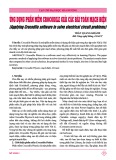
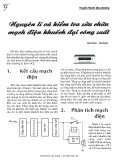


![Mạch Điện Điện Trở: [Thêm Mô Tả Chi Tiết Hấp Dẫn Tại Đây]](https://cdn.tailieu.vn/images/document/thumbnail/2013/20130917/butmaulam/135x160/1561226_146.jpg)

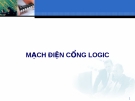
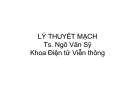
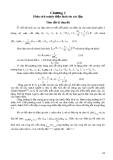

![Trắc nghiệm Mạch điện: Tổng hợp câu hỏi và bài tập [năm hiện tại]](https://cdn.tailieu.vn/images/document/thumbnail/2025/20251118/trungkiendt9/135x160/61371763448593.jpg)













